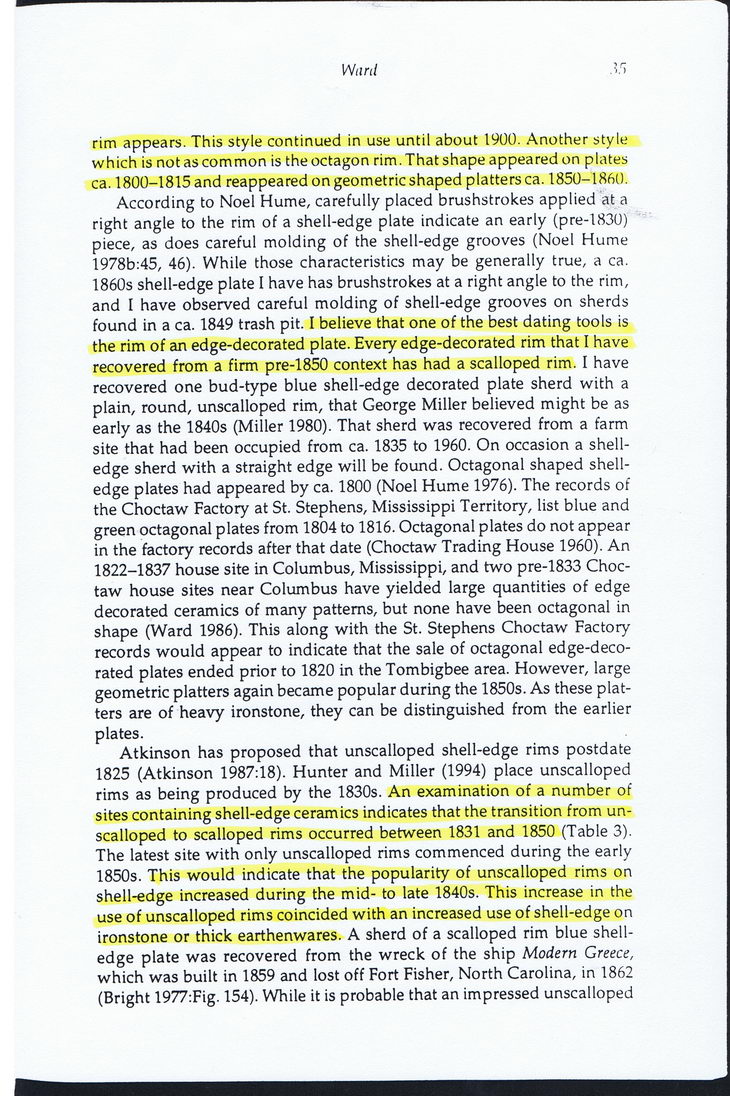This text was obtained via automated optical character recognition.
It has not been edited and may therefore contain several errors.
Ward rim appears. This style continued in use until about 1900. Another style which is not as common is the octagon rim. That shape appeared on plates ca. 1800-1815 and reappeared on geometric shaped platters ca. 1850-1860. According to Noel Hume, carefully placed brushstrokes applied at a right angle to the rim of a shell-edge plate indicate an early (pre-1830) piece, as does careful molding of the shell-edge grooves (Noel Hume 1978b:45, 46). While those characteristics may be generally true, a ca. 1860s shell-edge plate I have has brushstrokes at a right angle to the rim, and I have observed careful molding of shell-edge grooves on sherds found in a ca. 1849 trash pit. I believe that one of the best dating tools is the rim of an edge-decorated plate. Every edge-decorated rim that I have recovered from a firm pre-1850 context has had a scalloped rim. I have recovered one bud-type blue shell-edge decorated plate sherd with a plain, round, unscalloped rim, that George Miller believed might be as early as the 1840s (Miller 1980). That sherd was recovered from a farm site that had been occupied from ca. 1835 to 1960. On occasion a shell-edge sherd with a straight edge will be found. Octagonal shaped shell-edge plates had appeared by ca. 1800 (Noel Hume 1976). The records of the Choctaw Factory at St. Stephens, Mississippi Territory, list blue and green octagonal plates from 1804 to 1816. Octagonal plates do not appear in the factory records after that date (Choctaw Trading House 1960). An 1822-1837 house site in Columbus, Mississippi, and two pre-1833 Choctaw house sites near Columbus have yielded large quantities of edge decorated ceramics of many patterns, but none have been octagonal in shape (Ward 1986). This along with the St. Stephens Choctaw Factory records would appear to indicate that the sale of octagonal edge-deco-rated plates ended prior to 1820 in the Tombigbee area. However, large geometric platters again became popular during the 1850s. As these platters are of heavy ironstone, they can be distinguished from the earlier plates. Atkinson has proposed that unscalloped shell-edge rims postdate 1825 (Atkinson 1987:18). Hunter and Miller (1994) place unscalloped rims as being produced by the 1830s. An examination of a number of sites containing shell-edge ceramics indicates that the transition from unscalloped to scalloped rims occurred between 1831 and 1850 (Table 3). The latest site with only unscalloped rims commenced during the early 1850s. This would indicate that the popularity of unscalloped rims on shell-edge increased during the mid- to late 1840s. This increase in the use of unscalloped rims coincided with an increased use of shell-edge on ironstone or thick earthenwares. A sherd of a scalloped rim blue shell-edge plate was recovered from the wreck of the ship Modern Greece, which was built in 1859 and lost off Fort Fisher, North Carolina, in 1862 (Bright 1977:Fig. 154). While it is probable that an impressed unscalloped

Poverty Point (Indian Culture) Shell-edge Decorated Ceramics - Rufus Ward (09)